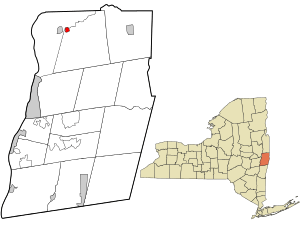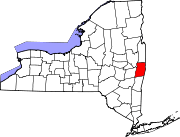Valley Falls, New York
| Valley Falls, New York | |
|---|---|
| Village | |
 Location in Rensselaer County and the state of New York. | |
 Valley Falls, New York Location within the state of New York | |
| Coordinates: 42°54′3″N 73°33′45″W / 42.90083°N 73.56250°WCoordinates: 42°54′3″N 73°33′45″W / 42.90083°N 73.56250°W | |
| Country | United States |
| State | New York |
| County | Rensselaer |
| Valley Falls | 1904 |
| Area | |
| • Total | 0.5 sq mi (1.2 km2) |
| • Land | 0.4 sq mi (1.1 km2) |
| • Water | 0.0 sq mi (0.1 km2) |
| Elevation | 335 ft (102 m) |
| Population (2010) | |
| • Total | 466 |
| • Estimate (2016)[1] | 455 |
| • Density | 930/sq mi (390/km2) |
| Time zone | UTC-5 (Eastern (EST)) |
| • Summer (DST) | UTC-4 (EDT) |
| ZIP code | 12185 |
| Area code(s) | 518 |
| FIPS code | 36-76672 |
| GNIS feature ID | 0968358 |
Valley Falls is a village in Rensselaer County, New York, United States. The population was 466 at the 2010 census. The village lies on the boundary of the towns of Pittstown and Schaghticoke, but is mostly in the northwest part of Pittstown.
History

In 1871, Industrialist James Thompson built a textile mill in the village.[2] Nearly all village residents worked in the mill and school kids ran home when the mill's lunch whistle sounded. After its height of operation in the 1970s it entered a decade of decline. The mill had been vacant for at least 10 years when it went up in flames in the early morning hours on April 22, 2009.[3]

By 1863 Valley Falls had established itself as a mini-industrial center. In addition to the aforementioned Thompson textile mill, the village also had a blacksmith shop, farrier shop, foundry, wainwright shop, cooperage, vineyard, three general stores, and two hotels. At this time only a single rail line (Troy & Boston RR) from Troy came through the southern limit of the village heading to Johnsonville, New York. Later, a second rail line from Schaghticoke would follow the Hoosic River past Thompson's Mill also heading to Johnsonville.[4] By the early 1970s the southern rail line was completely abandoned and had been largely dismantled; the northern line still functions to this day. However, with the closing of the Thompson mill the train no longer stops in Valley Falls.

Valley Falls in the hometown of Allan C. Balch, public utilities executive and namesake for Cornell's Balch Hall.[5]
The Adams–Myers–Bryan Farmstead was listed on the National Register of Historic Places in 2013.[6]
Geography
Valley Falls is located at 42°54′3″N 73°33′45″W / 42.90083°N 73.56250°W (42.900846, -73.562495).[7]
The Hoosic River unequally divides the village. The majority of the village is on the southern side of the Hoosic in the township of Pittstown and the "Village Annex" on the northern side is in the township of Schaghticoke.
According to the United States Census Bureau, the village has a total area of 0.5 square miles (1.3 km2), of which, 0.4 square miles (1.0 km2) of it is land and 0.04 square miles (0.10 km2) of it (4.35%) is water.
Demographics
| Historical population | |||
|---|---|---|---|
| Census | Pop. | %± | |
| 1870 | 600 | — | |
| 1880 | 782 | 30.3% | |
| 1910 | 835 | — | |
| 1920 | 633 | −24.2% | |
| 1930 | 577 | −8.8% | |
| 1940 | 564 | −2.3% | |
| 1950 | 555 | −1.6% | |
| 1960 | 589 | 6.1% | |
| 1970 | 681 | 15.6% | |
| 1980 | 554 | −18.6% | |
| 1990 | 527 | −4.9% | |
| 2000 | 491 | −6.8% | |
| 2010 | 466 | −5.1% | |
| Est. 2016 | 455 | [1] | −2.4% |
| U.S. Decennial Census[8] | |||
As of the census[9] of 2000, there were 491 people, 179 households, and 132 families residing in the village. The population density was 1,119.6 people per square mile (430.9/km²). There were 191 housing units at an average density of 435.5 per square mile (167.6/km²). The racial makeup of the village was 97.35% White, 1.43% Native American, 0.81% Asian, and 0.41% from two or more races. Hispanic or Latino of any race were 0.61% of the population.
There were 179 households out of which 42.5% had children under the age of 18 living with them, 55.9% were married couples living together, 15.6% had a female householder with no husband present, and 25.7% were non-families. 19.6% of all households were made up of individuals and 9.5% had someone living alone who was 65 years of age or older. The average household size was 2.74 and the average family size was 3.20.
In the village, the population was spread out with 30.8% under the age of 18, 5.7% from 18 to 24, 32.8% from 25 to 44, 20.0% from 45 to 64, and 10.8% who were 65 years of age or older. The median age was 35 years. For every 100 females, there were 91.1 males. For every 100 females age 18 and over, there were 92.1 males.
The median income for a household in the village was $56,250, and the median income for a family was $59,583. Males had a median income of $34,808 versus $28,750 for females. The per capita income for the village was $20,989. About 7.2% of families and 4.4% of the population were below the poverty line, including 7.4% of those under age 18 and none of those age 65 or over.
References
- 1 2 "Population and Housing Unit Estimates". Retrieved June 9, 2017.
- ↑ "Landmarks of Rensselaer County" "History of Pittstown" chapter, published 1897
- ↑ http://www.timesunion.com/ASPStories/Story.asp?storyID=792671&newsdate=5/2/2009&BCCode=MBTA
- ↑ "Maps of Rensselaer County" published 1863 p.25
- ↑ https://www.findagrave.com/memorial/63032960
- ↑ "National Register of Historic Places Listings". Weekly List of Actions Taken on Properties: 8/23/13 through 8/30/13. National Park Service. 2013-09-06.
- ↑ "US Gazetteer files: 2010, 2000, and 1990". United States Census Bureau. 2011-02-12. Retrieved 2011-04-23.
- ↑ "Census of Population and Housing". Census.gov. Retrieved June 4, 2015.
- ↑ "American FactFinder". United States Census Bureau. Retrieved 2008-01-31.
Further reading
| Wikimedia Commons has media related to Valley Falls, New York. |
- Anderson, George Baker (1897). Landmarks of Rensselaer County New York. Syracuse, New York: D. Mason and Company. OCLC 1728151.
- Hayner, Rutherford (1925). Troy and Rensselaer County New York: A History. New York: Lewis Historical Publishing Company, Inc. OCLC 22524006.
- Sylvester, Nathaniel Bartlett (1880). History of Rensselaer Co., New York with Illustrations and Biographical Sketches of its Prominent Men and Pioneers. Philadelphia: Everts & Peck. OCLC 3496287.
- Weise, Arthur James (1880). History of the Seventeen Towns of Rensselaer County from the Colonization of the Manor of Rensselaerwyck to the Present Time. Troy, New York: J. M. Francis & Tucker. OCLC 6637788.

